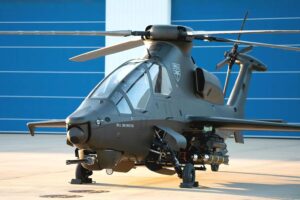Both contenders for the Army’s new Future Attack Recon Aircraft (FARA) have now received their General Electric T901 Improved Turbine Engined and have begun installation on their respective advanced rotorcraft.
Delivery of the engines is the last step before Sikorsy’s Raider X compound coaxial helicopter and Bell’s 360 Invictus tandem-cockpit conventional helicopters can test their advanced flight controls and avionics systems under their own power in preparation for ground runs.
Both companies announced they had received the engines from GE on Oct. 24. Previously both had been testing critical flight components and cockpit instrumentation using external power. Both teams also had 3D-printed, full-scale models of the engine on hand so they could design the engine bays.
“The ITEP delivery is a major milestone for FARA and the Bell 360 Invictus competitive prototype,” said Jayme Gonzalez, Bell’s FARA program manager. “Now that we have received the engine, we are ready to begin working toward ground runs and other necessary preparations before first flight later next year.”

Bell’s 360 Invictus competitive prototype. Bell Photo
The Improved Turbine Engine Program, or ITEP, is a 3,000-shaft-horsepower engine that should be 50 percent more powerful, use 25 percent less fuel, and have a 20 percent longer service life than the GE T0700 engines currently in the UH-60 Black Hawk and AH-64 Apache. Aside from powering FARA, the Army plans it as a drop-in replacement engine for those aircraft.
Initially intended to be ready for install in November 2022, GE struggled to provide an engine that could meet the Army’s exacting specifications. The Army prescribed that both companies use the GE engine for the aircraft, which will eventually fill the gap left by retirement of the OH-58D Kiowa Warrior armed aerial scout. The two rotorcraft will some of the most advanced military aviation technologies in operation once they begin flight testing. Both were designed with a modular open system architecture approach so that avionics and mission systems can be rapidly upgrade or swapped out with emerging technologies much faster than traditionally possible. In tandem with the fly off between Raider X and Invictus, the Army plans to hold the first of two Modular Open Systems Approach (MOSA) verification demonstrations this year.
Sikorsky’s engine arrived at its West Palm Beach, Fla., flight test facility on Oct. 20 and has transferred it to an engine integration lab neat to where Raider is being assembled. Raider X is now 98 percent complete. Integration of the new powerplant into the aircraft will begin immediately, the company said in a statement. Sikorsky is owned by Lockheed Martin.

Sikorsky’s Raider X competitive prototype. Sikorsky Photo
“Lockheed Martin’s model-based systems engineering approach gives the Sikorsky team confidence in this final phase of the RAIDER X build which brings us one step closer to completing this weapon system that will match the rapid pace of the reconnaissance mission,” said Sikorsky Future Vertical Lift Vice President Andy Adams. “The data RAIDER X gathers – and the speed and agility with which it operates – will support the Army’s mission for deep sensing capability and unsurpassed networking, connecting Soldiers and the joint force to the information they need to complete their missions.”
Once the engine is in, Sikorsky will commence final system tests and check-outs before turning on the powerplant to check out the drive system with the engine in the aircraft, Sikorsky said. After successful system checks, Sikorsky will conduct flight acceptance testing and proceed to first flight, which is expected in late 2024.
Both designs must be checked out and approved for flight by the Army.
While it waited for the engine, Bell’s team was focused on preparing the Invictus support infrastructure, supply chain and manufacturing hub, the company said. It is now prepared to instrument and install the T901 to prepare the aircraft for ground test operations.
Once the aircraft has been functionally tested with the T901 installed, Bell plans a Test Readiness Review and a restrained ground run. The 360 Invictus also carries a Pratt & Whitney PW207D1 to give it an extra push toward, and perhaps beyond, the Army’s 180-knot target speed for FARA.
“Our team has been hard at work to drive down risk in preparation for ground and flight tests,” said Chris Gehler, senior vice president and program director, FARA. “We are excited to receive the T901 engine and look forward to demonstrating the transformative capabilities of the Bell 360 Invictus. As well, we continue to advance and meet Army requirements for an open weapons system design that provides the next level of lethality and survivability into our warfighters’ arsenal.”